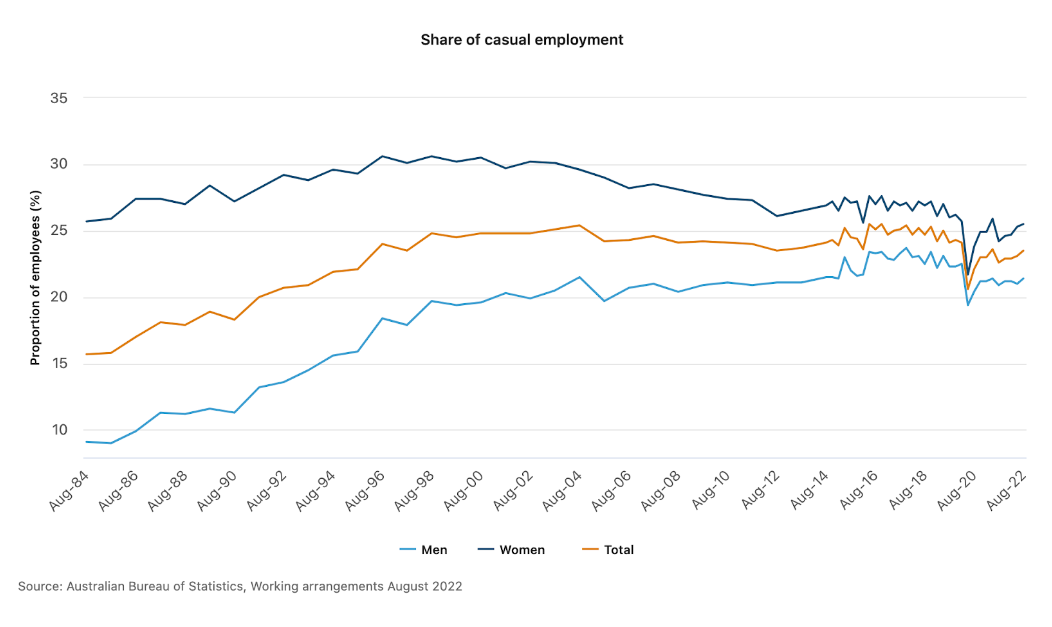
In the ever-evolving landscape of Australia's contractor workforce, employers play a pivotal role in attracting and retaining top talent. As we delve into the intricacies of this dynamic environment, it's crucial for employers to grasp the current state of casual employment, as highlighted by recent data from the Australian Bureau of Statistics (ABS).
The most recent ABS data reveals a substantial increase in casual employment, with 2.7 million casual employees constituting 23% of the workforce and 20% of all employed individuals. This surge, up from 2.4 million in August 2021, reflects a post-pandemic trend driven by a desire for increased flexibility among workers. While the proportion of casual employment had temporarily decreased to 20.6% in May 2020, the numbers are rebounding.

Moreover, the Australian job market is experiencing a transformation, marked by historically low unemployment rates and a persistent skills shortage. Employers now face the challenge of attracting and retaining top talent in a highly competitive environment. We talk more about this shift in a recent post - the urgency for employers to adapt to this changing landscape, where workers seek new opportunities and skills are in high demand.
Navigating the talent tug-of-war: employer strategies
The post-lockdown dynamics have shifted the balance of power toward employees, necessitating a strategic reassessment of internal value propositions by employers. To thrive in this competitive landscape, employers must stand out and attract exceptional professionals. The echoes of the pandemic have not only altered the job market but also reshaped candidate values and expectations. Let’s take a look at some strategies to win in a candidate-empowered market.
Flexibility in Hiring:
Embrace a Hybrid Work Model: Offer flexibility in work arrangements, allowing employees to split their time between remote and on-site work. For example, consider adopting a hybrid work policy that accommodates both in-person collaboration and remote productivity.
Flexible Hours and Job-Sharing: Allow employees to set flexible working hours or explore job-sharing arrangements. This demonstrates a commitment to accommodating diverse needs and promoting work-life balance.
Invest in Training and Development:
Skills Enhancement Programs: Implement training programs that focus on upskilling and reskilling employees to address specific skill gaps in your workforce. This could involve workshops, online courses, or partnerships with educational institutions.
Leadership Development Initiatives: Invest in leadership development to nurture internal talent. Identify high-potential employees and provide them with opportunities to grow into leadership roles.
Strategic Networking:
Industry Collaborations: Establish partnerships with industry organisations, professional associations, and educational institutions. This not only fosters collaboration but also opens avenues for attracting skilled professionals from these networks.
Attendance at Industry Events: Encourage employees to attend relevant conferences, seminars, and networking events. Building a presence at industry gatherings enhances your company's visibility and provides opportunities for talent acquisition.
Competitive Compensation and Benefits:
Benchmark Salaries: Regularly review and benchmark your salaries against industry standards to ensure they remain competitive. Consider conducting salary surveys to stay informed about compensation trends in your sector.
Attractive Benefits Packages: Offer a comprehensive benefits package that goes beyond basic health insurance. Include perks like flexible work hours, wellness programs, and professional development opportunities to make your offering stand out.
Employer Branding:
Showcase Company Culture: Use your online presence to highlight your company's unique culture, values, and workplace environment. Feature employee testimonials, success stories, and behind-the-scenes glimpses to showcase a positive workplace atmosphere.
Social Responsibility Initiatives: Engage in corporate social responsibility (CSR) initiatives that align with your company values. This demonstrates a commitment to social impact, attracting talent that values a sense of purpose in their work.
Achieving success in managing a contractor workforce in Australia requires employers to proactively adapt to the evolving environment. By understanding current trends, embracing flexibility, and implementing strategic initiatives, employers can position their organisations as preferred choices for top-tier talent in a competitive and dynamic job market. For personalised Talent Advisory and consultation tailored to your organisation's specific needs, we invite employers to reach out to FutureYou. Our team is dedicated to providing strategic insights and solutions to help you navigate the challenges of the evolving workforce landscape and secure the best talent for your success.
Related Articles:









